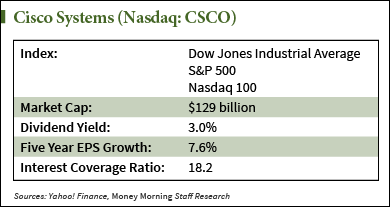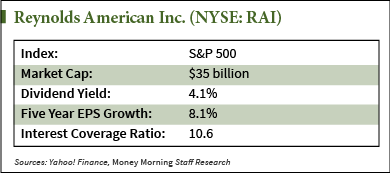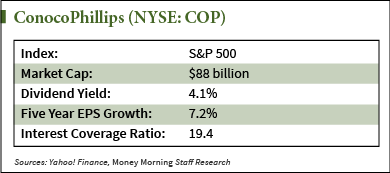Blue chip stocks are foundational investments that bring solid, safe returns for years. They're internationally recognized companies with strong financials, and they frequently pay dividends.
 The traditional list of blue chips includes names like Procter & Gamble Co. (NYSE: PG), The Coca-Cola Co. (NYSE: KO), and AT&T Inc. (NYSE: T). They're reliable stocks and have been for decades.
The traditional list of blue chips includes names like Procter & Gamble Co. (NYSE: PG), The Coca-Cola Co. (NYSE: KO), and AT&T Inc. (NYSE: T). They're reliable stocks and have been for decades.
And even though investors are repeatedly given the same list of blue chip stocks, there are new picks that can bring the same types of legacy profits.
In fact, we've found three stocks that can now be considered blue chips. They'll be reliable foundational plays in 2015 and for the foreseeable future - even if you don't see them on other blue chip lists.
Here's how we pinpointed the new class of blue chip stocks...
What Makes a Stock Blue-Chip Worthy
To determine the best upcoming blue chips, we created a list of five criteria that each company must meet:
- Must be a member of a major index. Because blue chip stocks are major companies and household names, we require that our new class of blue chips be tracked by one of the major S&P or Nasdaq indexes, or the Dow Jones Industrial Average.
- Must have a market cap over $30 billion. Large cap companies are defined as having a market cap over $10 billion. We went higher and picked a $30 billion minimum to ensure we're picking the biggest, most stable firms.
- Must pay regular dividends, and have a minimum yield of 2.5%. Dividend payments are another hallmark of blue chips. Investors want stocks that can bring modest returns even when the markets are underperforming. Strong and regular dividend payments ensure investors always see some income.
- Five-year EPS growth estimate over 5%. We also want companies projecting solid growth in the long term. Each of the companies listed below expects to increase earnings by at least 5% over the next five years.
- Interest coverage ratio over 10.0. The interest coverage ratio measures a company's ability to honor its debt payments. The higher the ratio, the better the financial shape of the company. An interest ratio under 1.0 means the company is not generating enough money to pay its interest expenses. All of these companies have strong ratios, above 10.0.
With those five criteria and future growth prospects in mind, here are our three new blue chip stocks for 2015 and beyond.
Three New Blue Chip Stocks for Long-Term Profits
Blue Chip Stock No. 1: Cisco Systems Inc. (Nasdaq: CSCO) designs, manufactures, and sells networking equipment. It's an Internet giant that was founded in 1984 and went public in 1990. At the height of the dot-com era, Cisco became the most valuable company in the world with a market cap over $600 billion.
Today, CSCO is still one of the strongest tech stocks on the market. CSCO shares trade near $27 and are up 49% over the last two years.
Looking forward, Cisco is investing heavily in the Internet of Everything (IoE). The IoE is an evolution of the Internet in which almost all of our day-to-day items become "smart" devices with Internet connectivity. Cisco estimates a value of $19 trillion for the market in the next decade.
 Cisco's work in this field will be a major catalyst for CSCO stock for years. It's at the foreground of the IoE movement, developing products like cloud-based TV delivery platforms and smart grid technologies.
Cisco's work in this field will be a major catalyst for CSCO stock for years. It's at the foreground of the IoE movement, developing products like cloud-based TV delivery platforms and smart grid technologies.
Here's how CSCO stacks up with our five parameters:
CSCO is one of 30 companies listed in the Dow Jones Industrial Average. It's also listed in the S&P 500 and the Nasdaq 100. The company's market cap is $136 billion.
The tech giant started paying a dividend in 2011, and has gradually increased it since. Today, CSCO offers a dividend yield of 2.8%.
Over the next five years, Yahoo! Finance projects EPS growth of 7.6% for CSCO. Finally, the company has a very favorable interest coverage ratio or 17.9 for 2014.
Blue Chip Stock No. 2: Reynolds American Inc. (NYSE: RAI) is a major tobacco company founded in 2004 after a merger between the U.S. business of British American Tobacco and R.J. Reynolds Tobacco Company.
Reynolds recently purchased rival Lorillard Inc. (NYSE: LO) for $27.4 billion. The deal will be finalized in 2015. The combined company will be the second-largest U.S. tobacco company and will control nearly 34% of the market.
But the most important part of this merger is Lorillard's electronic cigarette business.
The percentage of smokers in the U.S. has declined from 42% in 1965 to 18% in 2012, according to a Surgeon General's report.
However, e-cigs have grown in popularity. In fact, Wells Fargo analysts predict the e-cig market with be worth $10 billion by 2017. Right now, Lorillard controls half of that market.
The number of U.S. smokers may be shrinking, but RAI's revenue is still huge. For the full year 2014, analysts predict revenue of $8.46 billion for RAI. That's up from $8.24 in 2013.
"Even though the smoking rate has fallen all over, the market is still very much one of increased consumption," Money Morning's Chief Investment Strategist Keith Fitz-Gerald told readers in July.
 Here's how RAI stock fits our five blue chip parameters:
Here's how RAI stock fits our five blue chip parameters:
RAI stock is listed on the S&P 500 and has a market cap of $35 billion.
The company has a dividend yield of 4.1% right now. It has paid a dividend every quarter since its 2004 founding, though the value has fluctuated slightly.
RAI has a five-year EPS growth estimate of 8.3% and an interest coverage rate of 10.6.
Blue Chip Stock No. 3: ConocoPhillips (NYSE: COP) is the third-largest U.S. energy company.
Its operations in the Eagle Ford Shale of Texas and the Bakken Shale of North Dakota are absolutely booming. This past quarter, COP reported production from those two areas alone had increased 33% year over year.
 ConocoPhillips expects to increase production by 3% to 5% in 2015 - even with falling oil prices.
ConocoPhillips expects to increase production by 3% to 5% in 2015 - even with falling oil prices.
The price of oil has dropped nearly 27% from its June highs, and oil stocks like COP have been hit hard by investors fleeing the market. That's set up a great buying opportunity among oil stocks, particularly those with strong financials like COP.
Right now, COP stock trades near $73. It's already regained momentum and is up 8% in the last four weeks.
Here's how COP's financials measure up:
ConocoPhillips is included in the S&P 500 and has a market cap of $89 billion.
The stock currently yields 4%. It's paid a dividend every quarter since late 2000, and has increased its payments every year since 2005.
COP has a five-year EPS growth estimate of 7.24% and an interest coverage ratio of 19.4
What to Read Now: The U.S. economy remains king, but the gap is narrowing. Money Morning's Resource Specialist Peter Krauth has been tracking an unstoppable currency trend in China - one with global ramifications. And he's created a list of critical steps that will ensure investors take full advantage...


